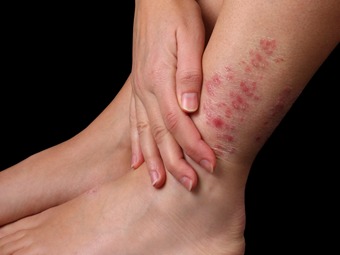 You may have peeling, itchy spots on any part of the skin. But on the feet such defects are found most often. This is due to the fact that the skin there more often becomes an "entrance gate" for various infections. We have compiled for you a list of the most common reasons for explaining what to do in each case.
You may have peeling, itchy spots on any part of the skin. But on the feet such defects are found most often. This is due to the fact that the skin there more often becomes an "entrance gate" for various infections. We have compiled for you a list of the most common reasons for explaining what to do in each case.
Features of the skin on the legs:
The lower limbs are the most remote part of the body from the heart. Therefore, the full blood supply is most often disturbed here. And if there is not enough nutrition of tissues (and skin including), then they are less resistant to infections, and to any damage, and also, they heal more slowly. The skin on the legs is drier than, for example, on the face. Cracks often are located there. Great chance to get a graze, to scratch. And any violation of the integrity of the integumentary tissues can initiate an infectious process.
When walking barefoot, we come into contact with surfaces on which pathogens of infections may be present. Everyone knows that the danger in swimming pools and public baths is especially increasing, where your wet foot skin is especially susceptible to infection.
Causes of itchy and flaky red spots on legs:
1. Fungal infection, mycosis. As a rule, spots are localized on:
- Feet;
- Fingers;
- Between the fingers.
Such areas are significantly different from healthy skin color, strongly itch, can peel. If you do not take any measures, the fungal infection will spread to other areas of the skin.
Although we see a lot of commercials with drugs "defeating mycosis", for successful treatment you need to see a doctor. The expert will put you a diagnosis (different fungi-pathogens are sensitive to different medications), take scrapings for analysis. Today, indeed, a lot of funds have been developed for the therapy of fungal infections, but it is important to carefully follow the scheme that the doctor will appoint. Also, you should definitely revise your attitude to personal hygiene in order to avoid contamination from now on.
2. Bacterial or viral infection origin of red spots on legs. Skin on the legs may be contaminated with other microorganisms. For example, red spots on legs can be a symptom of streptodermia or herpes. Symptoms of different types of infection are different. As in the case of mycosis, it is required to consult a doctor immediately. Especially if the rash has appeared in the child.
3. Scabies and red spots on legs. Parasitic disease, which affects not only the skin of the legs, but hands, back, trunk. Itching is worse in the evening and at night - this is the main sign by which you can suspect this particular disease. Rashes may look like:
- Pustules;
- Bubbles;
- And so on.
In addition to red spots, you can see in the thickness of the skin "strokes", gnawed with mites. Treatment should begin with a visit to a doctor who will prescribe medications for red spots on legs. In addition, you will need to do a lot of work to disinfect your personal belongings and objects that you are contacting.
4. In allergy red spots on legs, itching, peeling may appear due to contact with any chemical compounds, tissues, when the pollen of plants gets on the skin and so on. This type of reaction will be called "contact". In many cases, you will know what exactly an allergen caused it.
But there are also systemic allergy types, when, for example, an allergenic substance has got into the body with food, and the symptoms of pathology are found on the body. An example is atopic dermatitis, allergic eczema and so on.
If you once contacted any substance (for example, you used a new foot cream) and found yourself having an allergic reaction to it, then you just do not have to repeat such contacts. Redness and itching will pass by itself. You can take any antihistamine drug – Allegra, Claritin, etc.
But:
1. If you cannot reliably associate the appearance of red spots on legs and contact with a new material for you, the substance;
2. If you have a rash on your legs from time to time -
You should consult with a doctor. Many types of allergies require regular observation, support of the body.
5. Vascular disorders. With inflammation, impaired vascular permeability, stretching of their walls - hematomas (sinews), vascular asterisks - spots of different color may appear on the skin of the legs. Fabrics, the nutrition of which is broken, are prone to dryness, peeling. Attachment of secondary infection can cause itching.
The list of diseases in which the vessels of the lower extremities suffer is enormous: vasculitis, and varicose veins, and diabetes.
Let's start with the prevention of red spots on legs, which is shown to everyone - you need to do a contrasting pouring of feet with cold and hot water. Also, it is necessary to periodically take courses of vitamins (C, P, B5, A and E), which affect the state of the vessels. It is important to comply with the stress regime, so as not to overload your legs, but also not to let blood stagnate in the muscles. If the vascular health has already been affected, then you should go to the doctor to get competent help.
6. Hemangioma. This proliferation of vascular tissue is a benign tumor. If it is localized in the surface layer of the skin, then it does not cause any concern - it does not itch, it does not flake. It occurs in both children and adults. The tactics of treatment depend on the type of hemangioma. Some defects can resolve themselves, others require surgical intervention.




